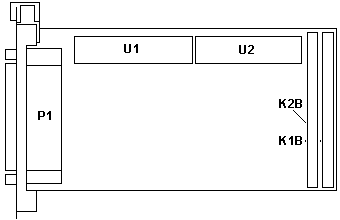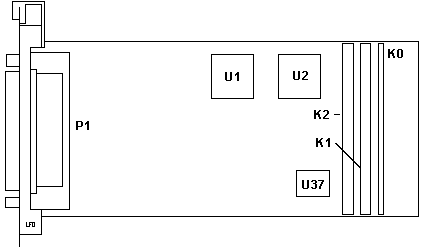|
@eff0.adf Realtime Interface
Co-processor Multiport/2 or X.25 /2 Adapter rcm153.exe OS/2 and DOS
Realtime Control Microcode (RCM) V1.53 README rcm204d.exe DOS Realtime Control Microcode (RCM) V2.04 README rcm204o.exe OS/2 Realtime Control Microcode (RCM) V2.04 README ARTIC
Multiport/2 Page on Quadron ARTIC Multiport/2 Hardware Technical Reference, 2d Ed, Oct 87 (~290 KB) ARTIC Multiport Model 2 & Portmaster EIB Developer's Guide, 2d Ed, Aug 96 (~210 KB) ARTIC X.25 Interface Co-Processor/2 Technical Reference, Ver 1.01, Sep 96 (~310 KB) ARTIC186 Software PublicationsARTIC AIX Support User's Guide, 5th Ed, Dec 98 (~325 KB)ARTIC C Language Support User's Guide, Version 1.03.01, Aug 96 Volume I - System Unit (~155 KB) Volume II - Co-Processor Adapter (~315 KB) ARTIC DOS Support User's Guide, Version 1.04, June, 1996 (~225 KB) ARTIC Extended Services User's Guide, 3rd Ed, Aug, 96 (~795 KB) ARTIC Firmware Technical Reference, 2d Ed, Jul 90 Volume 1 - System Interfaces and Functions (~140 KB) Volume 2 - Functions (~350 KB) Volume 3 - Data Structures (~560 KB) ARTIC OS/2 Support User's Guide, Ver 1.03.5, Jun 96 (~295 KB) ARTIC Support for Windows NT and Windows 98 User's Guide, 2d Ed, Mar 99 (~355 KB) X.25 Co-Processor Supt Program: Programmer's Reference Manual, 4th Ed Jun 96 (~410KB) X.25 Co-Processor Support Program: User's Guide, 4th Ed, Jun 96 (185 KB) Multiport/2 Base Card PN 16F2200 
Each ARTIC Multiport/2 is configured with
an Intel 80C186 processor, 512 KB to 1 MB of memory, and
the ability to expand the number and type of
communications ports using a variety of electrical
interface boards (EIBs) and cables. Any single port can
operate up to 38.4 Kbps, and, when expanded with an
eight-port EIB, all ports can communicate at 9600 bps. 4-ports RS-232 EIB 
If you can tell
me what this interface card is... It cane on a
Multiport/2 with 512K.
8 Port RS-232-D EIB  K0 30 pin header K1, K2 60 pin dual header P1 ?? pin port U1-U2 SCN26562C4A52 U37 33F5251 3333FF">U37 33F5251 Once again, please tell
me what this is!
part # 6263 ARTIC Multiport/2 512 KB 30 Pin SIMMS My sneaky suspicion- these are the same rare chips used by the SCSI w/cache 512K- Mitsubishi MH25609BJ-12 1MB- IBM 37F2016D 50F8938 LED Indicator Co-processor adapter PROM
8030 Serial Communications
Controllers (SSC) 8036 Counter/Timer and
Parallel I/O Unit (CIO) Realtime Control Microcode
(RCM) Watchdog Timer Shared Storage Interface Chip
Direct Memory Access
Applications and Information about ARTIC cards Quadron Corporation
Synchronous
Communications @EFF0H IBM Realtime Interface Co-processor Multiport/2 or X.25 /2 Physical Card Number The IBM Realtime Interface Co-processor Multiport/2 or X.25 Interface Co-processor/2 supports up to 16 different adapters in various RAM/ROM locations, utilizing 7 different interrupt levels and various clocking options. The Physical Card Designation will be automatically configured with the following rules: 1. I/O address (Physical Card Designation) is the lowest possible interrupt level. The I/O address defines the physical card designation of the IBM Realtime Interface Co-processor Multiport/2 or X.25 Interface Co-processor/2. This is actually a RANGE of addresses, 8 bytes wide. The preferred address range is the lowest available. <"Physical Card 0; 02A0H-02A7H">, Physical Card 1; 06A0-06A7, Physical Card 2; 0AA0-0AA7, Physical Card 3; 0EA0-0EA7, Physical Card 4; 12A0-12A7, Physical Card 5; 16A0-16A7, Physical Card 6; 1AA0-1AA7, Physical Card 7; 1EA0-1EA7, Physical Card 8; 22A0-22A7, Physical Card 9; 26A0-26A7, Physical Card A; 2AA0-26A7, Physical Card B; 2EA0-2EA7, Physical Card C; 32A0-32A7, Physical Card D; 36A0-36A7, Physical Card E; 3AA0-3AA7", Physical Card F; 3EA0-3EA7" Shared Storage Window Location & Size The IBM Realtime Interface Co-processor Multiport/2 or X.25 /2 supports up to 16 different adapters in various RAM/ROM locations utilizing 7 different interrupt levels and various clocking options. The Memory Location will be automatically configured with the following rules: 1. Memory address is the lowest possible and the Shared Storage Window size is 8KB. The Shared Storage Window is an unused ROM or RAM address range that is used as a window into the RAM on the IBM Realtime Interface Co-processor Multiport/2 or X.25 /2. The preferred choice is the window at the lowest address with a size of 8K. The 8K window size is compatible with the IBM Realtime Interface Co-processor and the IBM Realtime Interface Co-processor/Multiport. 8K window <1MB <"C0000H-C1FFFH (8K Window)">, C2000-C3FFF, C4000-C5FFF, C6000-C7FFF, C8000-C9FFF, CA000-CBFFF, CC000-CDFFF, CE000-CFFFF, D0000-D1FFF, D2000-D3FFF, D4000-D5FFF, D6000-D7FFF, D8000-D9FFF, DA000-DBFFF, DC000-DDFFF, DE000-DFFFF 16K window <1MB <"C0000H-C3FFFH (16K Window)">, C4000-C7FFF, C8000-CBFFF, CC000-CFFFF, D0000-D3FFF, D4000-D7FFF, D8000-DBFFF,DC000-DFFFF 32K window <1MB <"C0000H-C7FFFH (32K Window)">, C8000-CFFFF, D0000-D7FFF, D8000-DFFFF 64K window <1MB <"C0000H-CFFFFH (64K Window)">, D0000-DFFFF ;================================================================ ; Above 1 megabyte configurations = ;================================================================ 8K window >1MB <"FC0000H-FC1FFFH (8K Window)">, FC2000-FC3FFF, FC4000-FC5FFF, FC8000-FC9FFF, FCA000-FCBFFF, FCC000-FCDFFF, FCE000-FCFFFF, FD0000-FD1FFF, FD2000-FD3FFF, FD4000-FD5FFF, FD6000-FD7FFF, FD8000-FD9FFF, FDA000-FDBFFF, FDC000-FDDFFF, FDE000H-FDFFFF 16K window >1MB <FC0000H-FC3FFFH (16K Window)">, FC4000-FC7FFF, FC8000-FCBFFF, FCC000-FCFFFF, FD0000-FD3FFF, FD4000-FD7FFF, FD8000-FDBFFF, FDC000-FDFFFF 32K window >1MB <"FC0000H-FC7FFFH (32K Window)">, FC8000-FCFFFF, FD0000-FD7FFF, FD8000-FDFFFF 64K window >1MB <"FC0000H-FCFFFFH (64K Window)">, FD0000-FDFFFF Interrupt Level The IBM Realtime Interface Co-processor Multiport/2 or X.25 /2 supports up to 16 different adapters in various RAM/ROM locations, utilizing 7 different interrupt levels and various clocking options. The Interrupt Level will be automatically configured with the following rules: 1. Interrupt Level 7 is requested. 2. Interrupt Levels are then requested for subsequent cards in ascending order. The interrupt level is the prioritized interrupt request line on which the IBM Realtime Interface Co-processor Multiport 2 or X.25 /2 will interrupt the Personal System 2. The interrupt priorities are as follows (greatest priority first): 9, 10, 11, 12, 3, 4, 7. The preferred interrupt level is 7. <"Interrupt Level 7">, 3, 4, 9, 10, 11, 12 Port 0 Transmit Clock Source The IBM Realtime Interface Co-processor Multiport/2 or X.25 /2 supports up to 16 different adapters in various RAM/ROM locations, utilizing 7 different interrupt levels and various clocking options. The Port 0 Transmit Clock Source will be automatically configured to provide DCE sourced transmit clocking. The Co-processor can be configured to provide Data Terminal Equipment (DTE) sourced transmit clocking (i.e. the clock is sourced by the Co-processor) or Data Computer Equipment (DCE) sourced transmit clocking (e.g. a modem). <"DCE sourced clocking">, DTE sourced clocking Port 0 Receive Clock Source The IBM Realtime Interface Co-processor Multiport/2 or X.25 /2 supports up to 16 different adapters in various RAM/ROM locations, utilizing 7 different interrupt levels and various clocking options. The Port 0 Receive Clock Source will be automatically configured as REMOTE. The Co-processor Receive (RX) clock can be either LOCAL or REMOTE, depending on whether or not a remote clock is used (e.g. from a modem or other DCE). The LOCAL clock has a Digital Phase Locked Loop (DPLL), optionally defined as divided by 16 or divided by 32, depending on the application clocking scheme. <"DCE Sourced Remote Clocking">, DPLL Clk/16 Local Clocking, DPLL Clk/32 Local Clocking Port 1 Transmit Clock Source The IBM Realtime Interface Co-processor Multiport/2 or X.25 /2 supports up to 16 different adapters in various RAM/ROM locations, utilizing 7 different interrupt levels and various clocking options. The Port 1 Transmit Clock Source will be automatically configured to provide DCE sourced transmit clocking. The Co-processor can be configured to provide Data Terminal Equipment (DTE) sourced transmit clocking (i.e. the clock is sourced by the Co-processor) or Data Computer Equipment (DCE) sourced transmit clocking (e.g. a modem). <"DCE sourced clocking">, DTE sourced clocking Port 1 Receive Clock Source The IBM Realtime Interface Co-processor Multiport/2 or X.15 /2 supports up to 16 different adapters in various RAM/ROM locations, utilizing 7 different interrupt levels and various clocking options. The Port 1 Receive Clock Source will be automatically configured as REMOTE. The Co-processor Receive (RX) clock can be either LOCAL or REMOTE, depending on whether or not a remote clock is used (e.g. from a modem or other DCE). The LOCAL clock has a Digital Phase Locked Loop (DPLL), optionally defined as divided by 16 or divided by 32, depending on the application clocking scheme. <"DCE Sourced Remote Clocking">, DPLL Clk/16 Local Clocking, DPLL Clk/32 Local Clocking |